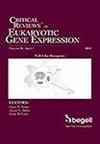MicroRNA-17 Family Targets RUNX3 to Increase Proliferation and Migration of Hepatocellular Carcinoma.
IF 1.5
4区 医学
Q4 BIOTECHNOLOGY & APPLIED MICROBIOLOGY
Critical Reviews in Eukaryotic Gene Expression
Pub Date : 2023-01-01
DOI:10.1615/critreveukaryotgeneexpr.2022043382
引用次数: 1
Abstract
Hepatocellular carcinoma (HCC) is one common cancer in the world. Previous studies have shown that miR-17 family members are elevated in most tumors and promote tumor progression. However, there is no comprehensive analysis of the expression and functional mechanism of the microRNA-17 (miR-17) family in HCC. The aim of this study is to comprehensively analyze the function of the miR-17 family in HCC and the molecular mechanism of its role. Bioinfoimatics analysis of the miR-17 family expression profile and its relationship to clinical significance using The Cancer Genome Atlas (TCGA) database, and this result was confirmed using quantitative real-time polymerase chain reaction. miR-17 family members were tested for functional effects through transfection of miRNA precursors and inhibitors, and monitoring cell viability and migration by cell count and wound healing assays. In addition, we using dual-luciferase assay and Western blot demonstrated the targeting relationship between the miRNA-17 family and RUNX3. These members of miR-17 family were highly expressed in HCC tissues, and the overexpression of the miR-17 family promoted the proliferation and migration of SMMC-7721 cells, whereas treatment with anti-miR17 inhibitors caused the opposite effects. Notably, we also found that inhibitors anti-each member of miR-17 can suppress the expression of the entire family member. In addition, they can bind to the 3' untranslated region of RUNX3 to regulate its expression at the translational level. Our results proved that miR-17 family has oncogenic characteristics, overexpression every member of the family contributed to HCC cell proliferation and migration by reducing the translation of RUNX3.MicroRNA-17家族靶向RUNX3增加肝细胞癌的增殖和迁移
肝细胞癌(HCC)是世界上常见的一种癌症。先前的研究表明,miR-17家族成员在大多数肿瘤中升高,并促进肿瘤进展。然而,目前还没有对microRNA-17 (miR-17)家族在HCC中的表达及其功能机制进行全面分析。本研究的目的是综合分析miR-17家族在HCC中的功能及其作用的分子机制。使用the Cancer Genome Atlas (TCGA)数据库对miR-17家族表达谱及其与临床意义的关系进行生物信息学分析,并使用定量实时聚合酶链反应证实这一结果。通过转染miRNA前体和抑制剂,并通过细胞计数和伤口愈合试验监测细胞活力和迁移,检测miR-17家族成员的功能影响。此外,我们通过双荧光素酶测定和Western blot验证了miRNA-17家族与RUNX3之间的靶向关系。这些miR-17家族成员在HCC组织中高表达,miR-17家族的过表达促进了SMMC-7721细胞的增殖和迁移,而使用抗mir17抑制剂治疗则会产生相反的效果。值得注意的是,我们还发现抗miR-17每个成员的抑制剂可以抑制整个家族成员的表达。此外,它们可以结合到RUNX3的3'非翻译区,在翻译水平上调控RUNX3的表达。我们的研究结果证明了miR-17家族具有致癌特征,该家族的每一个成员的过表达都通过降低RUNX3的翻译来促进HCC细胞的增殖和迁移。
本文章由计算机程序翻译,如有差异,请以英文原文为准。
求助全文
约1分钟内获得全文
求助全文
来源期刊

Critical Reviews in Eukaryotic Gene Expression
生物-生物工程与应用微生物
CiteScore
2.70
自引率
0.00%
发文量
67
审稿时长
1 months
期刊介绍:
Critical ReviewsTM in Eukaryotic Gene Expression presents timely concepts and experimental approaches that are contributing to rapid advances in our mechanistic understanding of gene regulation, organization, and structure within the contexts of biological control and the diagnosis/treatment of disease. The journal provides in-depth critical reviews, on well-defined topics of immediate interest, written by recognized specialists in the field. Extensive literature citations provide a comprehensive information resource.
Reviews are developed from an historical perspective and suggest directions that can be anticipated. Strengths as well as limitations of methodologies and experimental strategies are considered.
 求助内容:
求助内容: 应助结果提醒方式:
应助结果提醒方式:


